
Featured
The Silent Voices of African Divination
By Philip M. Peek
Even after several decades of research on African diviners and divination systems, the subject continues to fascinate me because of divination’s importance in daily human lives, its centrality in cultural systems, its articulation of values and laws, and its breadth of artistry. Divination is an incredibly rich area for anthropological research—in fact, I would argue that there is no richer ethnography of a culture than the study of its divination system. In a very real sense, as the Yoruba of Nigeria explicitly state about their system of Ifa, a divination system constitutes a people’s “book of knowledge” wherein their history and cultural guidelines are maintained.
My working definition of divination is:
A divination system is a standardized process deriving from a learned discipline based on an extensive body of knowledge. This knowledge may or may not be literally expressed during the interpretation of the oracular message. The diviner may utilize a fixed corpus, such as the Yoruba Ifa Odu verses, or a more diffuse body of esoteric knowledge. Divining processes are diverse, but all follow set routines by which otherwise inaccessible information is obtained. Some type of device usually is employed, from a simple sliding object to the myriad symbolic items shaken in diviners’ baskets. Sometimes the diviner’s body becomes the vehicle of communication through spirit possession. Some diviners operate self-explanatory mechanisms that reveal answers; other systems require the diviner to interpret cryptic metaphoric messages. The final diagnosis and plan for action are rendered collectively by the diviner and the client(s).1
We usually assume “communication” in divination entails audible speech, although we do secondarily acknowledge a number of nonverbal modes of communication. It is critical to stress that African divination systems are multisensory and variously utilize all forms of communication. One aspect has particularly fascinated me: the use of “silent” objects and creatures as agents of communication between worlds. While humans are greatly concerned about the “other,” spiritual world, it is normally a silent world and must be given voice somehow in order for communication to take place. In African divination systems, this cross-world communication often takes the form of “spirit possession” of diviners whereby “silent” ancestors or spirit entities speak through the diviner. Equally, it is understood that the other world “speaks” through otherwise inanimate divinatory objects, such as marked tablets, half-shells on a string, or objects in a diviner’s basket.
Another frequently encountered assumption about divination is that the diviner is a totally “unique” individual, in the Western sense of a singular person. In fact, African diviners are, literally, complex individuals often constituted of a number of discrete elements. Most African societies hold that individuals must maintain proper relations with their spirit doubles (as well as other entities) in order to live a good life. For diviners this is even more critical. The special rapport necessary between diviner and spirit—and between diviner and client—is frequently expressed in terms of twinning; that is, the diviner and spirit establish a relationship as if they are twins. From her research with the Djimini Senufo of Côte d’Ivoire, Ellen Suthers offers the following interpretation:
Sharing the same womb experience, twins become endowed with, or constituted of, the same perceptions; hence they emerge in the world having congruent images. Because they share perfect knowledge and perceptions of each other and of the spirit realm, twins do not need speech to communicate with each other or with the host of spiritual entities. … As pairing makes the client congruent with the diviner and the diviner congruent with the spirits, all come to share a common perception. Through gestures, the diviner transforms his or her body to reflect the image of the client, and thus to reveal the client’s problem in concrete terms.2
I think this description perfectly expresses the critical dynamics of divination in many African cultures, those esoteric processes that operate whether through diviners or through their devices. Once this perspective is recognized, many representations of it can be found. For example, among the Baule of Côte d’Ivoire, West Africa, diviners’ home shrines always include pairs of spirit figures that aid their enterprise. Sometimes these images depict two figures back-to-back in a Janus pose, or one on the shoulders of another, as if to portray the merging of diviner and spirit. Indeed, most diviners (komien) work with a variety of spirit helpers who “possess” the diviner during divination sessions in order to provide oracular messages.
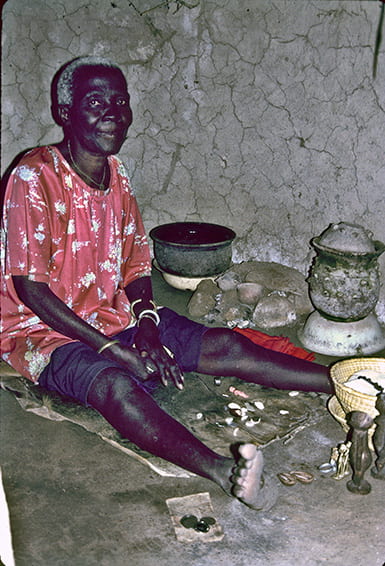
Senufo Sandogo diviner, Côte d’Ivoire (2001). Photo by Philip M. Peek
Near Korhogo in northern Côte d’Ivoire, a Senufo diviner, a member of the Sandogo, an association of women who practice divination, sets up dual images in front of her while she divines in her “hut for twins.” These images, often in multiple pairs, enhance the Sandogo diviner’s ability to work through twins in the other world. The diviners’ images are always pairs of a male and a female. This raises a related and essential understanding found throughout West African cultures: the “perfect” pair of twins is male and female.3
As part of their divination ritual, Yaka diviners from the Democratic Republic of the Congo use a slit gong, which incorporates both male and female symbolic forms representing male and female genitalia. Here, as so often in divination, we find male and female pairing and the suggestion of androgyny. Intriguingly, the diviner considers the slit gong his “twin”: it facilitates his reception of occult messages.4
Androgyny seems to be a common goal among the African cultures where diviners engage in cross-gender dressing. Examples can be found among peoples from West, Central, and Southern Africa. I have long thought that this might reflect an understanding of spiritual entities as androgynous themselves (as opposed to mere humans of single sexes), and that such a posture would have value for the diviner when dealing with male and female clients.
“Twinning” occurs not only in the relationships of diviners and spirits, but between diviners and clients. Not only do complex relations develop around the psychological dynamics between diviners and clients, but there is often a literal, physical bonding of the two to ensure a successful divination session. The Lobi of Burkina Faso use a hand-holding type of divination wherein the diviner holds the client’s right hand in his left hand; the raising and lowering of their clasped hands gives “yes” and “no” answers to their questions. Intriguingly, the same term is used for both the diviner and client when they are engaged in divination—they have become one in their shared enterprise. Among the Batammaliba of Togo, both client and diviner hold a stick, and its movements convey the oracular message.5
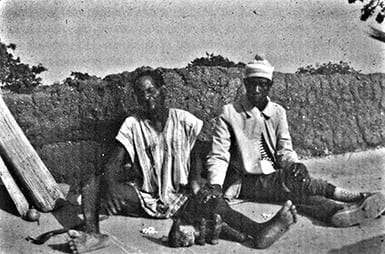
Lobi diviner, left, with client in Gbuntara, Burkina Faso (1980). Photo by Piet Meyer
Luba diviners in the Democratic Republic of the Congo also work in pairs (opening photo, at top). A man and his son, with their wives, are divining with their paired pots: “proof” (past events, causes) and “promise” (future, interpretations). Many symbolic objects in the pot are shaken and their configurations are “read” to provide answers and actions for the clients. References to twins are found throughout the Luba divination system, from the songs that are sung to the elegant carvings depicting female twins holding a divination bowl.6 Another example of the many forms “twinning” takes in African divination systems comes from my research among the Isoko of the Niger Delta in southern Nigeria.
The two diviners are using the eva system, which is related to the opele (divining chain) of the Yoruba that is incorporated into their major system of Ifa. These chains are constructed of eight half-seed shells, which can fall with either their concave or convex sides upwards. Working in pairs, each diviner casts his two chains. Then, in turn, each quickly “reads” the other’s cast using the esoteric eva language while the other rapidly translates into standard Isoko. Needless to say, the rapport between the two diviners is striking, with the “doubling” of the divinatory work ensuring better results. The reason that twins are critical among the Senufo and other West African peoples is that they have shared the womb together and have “perfect knowledge and perception of each other.” For that reason, “twins do not need speech to communicate with each other or with a host of spiritual entities”; further, the Senufo hold that “too much talk obstructs the passage of knowledge.”7 This brings me to a second thread from Ellen Suthers’s research, that of “silent” communication. In several other West African cultures, including the Lobi and Batammaliba, we find further support for the importance of silence and its links to twinning. The Lobi maintain that the thila (protective spirits) have no tongues and can only communicate through humans—but only by means of the joined hands of the diviner and client during divination.8 The Batammaliba of Togo also engage in “silent” communication through divination, as the diviner interprets the movements of the staff he and the client hold as it responds to their questions. “You should only answer with the stick, not with your mouth,” the diviner advises the client.9
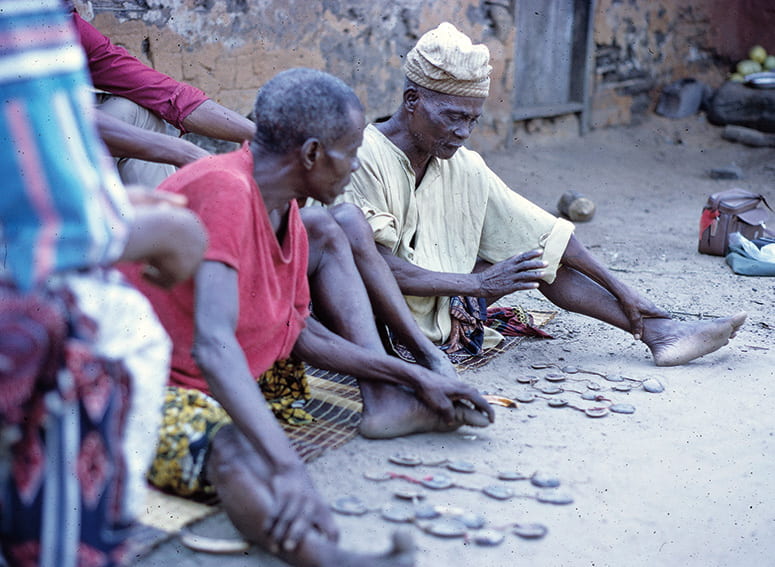
Isoko eva diviners Eture Egbedi, left, and his assistant in Ole, Nigeria (1971). Photo by Philip M. Peek
The topic of silence has fascinated me for many years. Silence is not a “normal” condition for humans; we have to create silence by not doing what we usually do. Because we normally make noise and usually define humanness by the ability to speak, to restrict or prevent speech is noteworthy. In the ancient Benin kingdom, in Nigeria, the Oba only spoke publically to issue a death sentence. The neighboring Yoruba kings still wear crowns with beaded veils so that one cannot see them speak—which, in any case, they seldom do. Virtually all persons of status, certainly in West African societies, have those who speak for them.
Silence is not simply an emblem of royal power, however. It is also interpreted widely as an indication of wisdom. The person who speaks only occasionally, slowly and cautiously, is the one to listen to, not the fast talker “talking anyhow” (as Nigerians phrase it). Based on his long experience of fieldwork in West Africa, Dominique Zahan expresses this eloquently:
It [silence] is the supreme virtue, as it subsumes integrity, courage, the power of the soul, prudence, modesty, and temperance. Silence defines the man of character, and is the attribute of the wise man; it is a type of wisdom. He who knows how to be silent possesses true happiness, interior peace, and detachment.10
This leads to my discussion of silent animals. All cultures use animals to represent their values, and, just as animals “speak” for humans in folktales and so on, their “silence” is equally significant. From the Kaguru of East Africa, T. O. Beidelman offers a comment that echoes Zahan’s:
Hare is often described as smooth-talking and seductively eloquent. In fact, hares appear to be silent creatures, a quality which Karugu also associate with wisdom. While Kaguru highly value eloquence, in general they associate voluble speech and garrulity with fatuous silliness, qualities more appropriately linked with hyenas.11
We might first think that those animals with distinct voices or sounds would be the chosen divinatory creatures, but they are not. Lions and elephants rarely figure in divination, nor do parrots or other creatures whose calls we often mimic. In fact, despite such abilities as mimicking human speech, little is found about parrots in African cultural practices. Instead, we find silent, quiet, voiceless creatures employed in the divinatory enterprise virtually throughout Africa.12
Specific animals (in part, as a whole, or symbolically) permeate African divination systems. These are serious choices and none are without meaning. But one must be very cautious when interpreting these choices, because the representations are culturally determined and may or may not relate to “natural” observations, especially in ritual contexts. Owls are wise to Europeans but are witches for many Africans. Nature is not “natural” but cultural, and the criteria by which choices are made may be quite obscure to outsiders. While my discussion here deals with creatures actually employed in divination systems, accenting the “silent” component must be seen as an argument from my own academic perspective.
At the same time, to underscore my emphasis on emic (i.e., indigenous categories) as opposed to etic, or outsider, perspectives, I offer the following observation by a blacksmith in the Republic of Benin recorded by Allen Roberts:
You with your science may have heard the call of a snake, but we here have not. It is difficult to know a snake’s voice. The monitor [lizard] is like this too, and cannot be heard, but it is a powerful animal and it has a forked tongue, as well, which people feel is a bizarrerie. It goes on land and in the water, and so is above other animals.13
Many of the creatures linked to divination are ambiguous, anomalous, seemingly “betwixt and between” cultural classifications. In such culturally determined, liminal states we often encounter reptiles and snakes, pangolins and aardvarks, flying squirrels, and chameleons. The otter-shrew in Yaka (Democratic Republic of the Congo) belief aids diviners because it moves between water and land. Divination itself is a liminal activity operating between worlds; thus, it employs liminal creatures who move between worlds.

Dogon diviners reading the Pale Fox’s tracks, Mali (1997). Photo by Walter E. A. van Beek
Another broad category among African peoples that might inform us about choices of divinatory agents is that of the trickster figure. Why is it that the most popular tricksters are tortoises, rabbits, spiders? Yes, they are small and silent; but they are also very clever, if not wise. The Yoruba system of Ifa is rigorous and demanding, with diviners trained for at least sixteen years; but also on the Ifa tray is the face of Eshu the Trickster, who is the messenger between humans and the other world and who can affect all divination sessions. Perhaps this is another reminder of the dangers of verbal communication and the importance of silence.
Examples of silent animals in divination abound. The Dogon live in villages set along the plateaus and against the high cliffs of central Mali. At dusk, diviners prepare complex grids of symbols in the sands at the edge of the village; corn kernels are scattered over the diviner’s diagram. At dawn the next morning, diviners return to read the patterns of the fox’s paw prints for the oracle’s answers to their questions. Note the liminality in space and time—a common feature of many African divination systems. Divination occurs neither during day nor at night, and neither in the village nor in the bush.
Intriguingly, this system overlays the fox’s nonverbal answers onto the human’s nonverbal questions. In Dogon mythology, the “Pale Fox” was deprived of speech due to his transgressions. Thus, akin to the Lobi thila, an otherwise mute but knowledgeable entity is only given voice through divination in order to aid humans. As if to underscore this point, the other popular divination agent for the Dogon is the ant. A number of African societies utilize insects in divination; the Azande of the Sudan use ants as well.
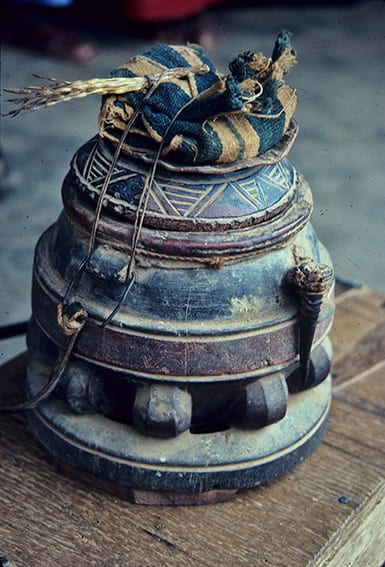
Baule mouse oracle container, Côte d’Ivoire (1998). Photo by Philip M. Peek
I return to the Baule and Guro of Côte d’Ivoire for my next example, a mouse oracle vessel. Among its external decorations are a porcupine tail and red duiker horns—from creatures who are both silent and nocturnal (another frequent characteristic of creatures linked to divination). It is believed that mice “never lie” and that they hear the “sounds of the earth.”14
Mouse divination is a fragile and complex enterprise. A mouse is captured and placed in the bottom chamber. The top chamber holds the divination device: a small tortoise shell with ten chicken wing bones or, better, bat wing bones. Of the ten bones, the five on the left represent living human types, while the five to the right stand for ancestors and various dangers. Among the neighboring Yohure, it is said that mice lost their voices because they always run and hide; so they can only communicate through the bones. Corn kernels are scattered in the dish and the top is replaced on the container. The mouse crawls up to the upper chamber and eats some corn, thereby rearranging the bones. The top is removed and the diviner reads the resultant pattern.
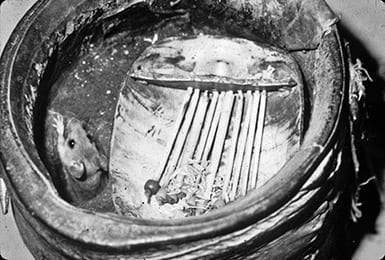
Guro mouse oracle, Côte d’Ivoire (1990). Photo by Lorenz Homberger
One of the world’s most remarkable creatures is the chameleon. Cultures the world over note its ability to change its skin color and its independently rotating eyes. While not absolutely without voice (it will hiss if disturbed), most reckon it to be silent. Throughout Africa, chameleons are held to be among the world’s oldest and wisest of creatures. With their primordial and supernatural status, they have great wisdom of the mysteries of the past and of the future. While chameleons are not, to my knowledge, directly employed in divination, they are frequently portrayed in their role as trusted messengers to the other world on iron shrine staffs outside diviner’s shrines in West Africa. The slit-gong used by Yaka diviners often has the head of a chameleon carved at the top, or a tortoise head can also be depicted. Here again, the chameleon acts as messenger, with another silent creature as an alternate. Chameleons and diviners are also linked among the Senufo, where, again, the twinning idea comes forth in the twinned chameleon rings diviners often wear.
Throughout Africa, religious and political leaders are distinguished by having others who speak for them. Among the Ashanti of Ghana such spokesmen, okeyame, carry elaborate staffs decorated with symbols signifying famous proverbs. “We speak to a wise man in proverbs, not in plain language.”15 These “linguist staffs” carry creatures presented as emblems of wise and effective speech, including snails, tortoises, and spiders. Although these are not exactly the creatures which first come to mind when we think of oral communication (one cannot be much quieter than a spider), for the Ashanti, all these creatures are associated with wisdom. In fact, the spider is the supreme tale-teller of all animals and, as Anansi, is also a wondrous trickster. Snails are often used in medicinal preparations and are thought to “cool” heated individuals and conditions. The Isoko provide a wonderful example of how a “speechless” creature aids human speech: they use snails to cure stuttering. Although the silence and slow speed of snails does not seem to recommend them as divinatory agents, they are encountered in divinatory paraphernalia throughout Africa, as with diviners in Mozambique. Likewise, the tortoise is a frequent character in African folk tales and is considered one of the wisest of animals. Its slow and deliberate behavior seems to be what is most recognized as demonstrating its wisdom, but its silence is also noteworthy. Tortoise shells often hold diviners’ apparatuses, as among the Baule and Senufo.
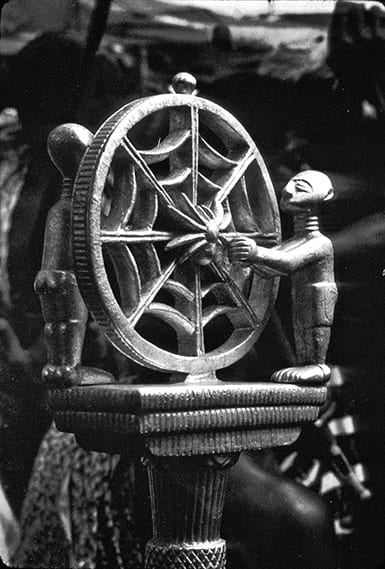
Ashanti okeyame staff (1976). Photo by Doran Ross
One can imagine the behavior of spiders leading to its association with the “weaving” of tales and being a supreme observer of human behavior from its vantage point of a ceiling corner, but it is as a speaker that the Ashanti recognize the spider’s abilities. This is not an antiquated belief. When I visited W. E. B. Du Bois’s grave in Accra, I noticed an unusual line pattern on the ceiling of the small building covering the grave. I thought it looked like a spider’s web and when I asked an attendant at the home, I was told that, yes, indeed, it was a web, to reflect Du Bois’s extraordinary communication abilities. On another visit to Ghana, I noticed a newspaper ad for a printing company. Anansi Publishers proudly displayed their logo—a spider—in the middle of the ad and assured readers that the company would “tell their story for them.”
A divination system based on the spider exists in Cameroon. Spiders are depicted in the royal arts of Cameroon kings because they are mediators between gods and men. Among a number of peoples in Cameroon, the ground-dwelling spider is the main agent of divination primarily because it lives near the ancestors in the earth. The diviner draws out a large number of marked leaf “cards” from a container lying on the tail of a squirrel (who is also considered a messenger between worlds). These cards are placed near the spider’s burrow and all is covered. When the lid is removed, the spider’s alterations of the cards are “read” by the diviner.
Another form of divination, also from Cameroon, employs a close relative of the spider (at least in our scientific typology), the land crab, also a silent creature. Among the Kapsiki of northwestern Cameroon, specially marked pieces of gourd are placed in a container with the crab and all is covered. After about fifteen minutes, the cover is removed and the rearrangement of objects is studied. Partial answers are perceived; then the whole procedure is repeated until the diviner is satisfied with the revelations made by the crab.16
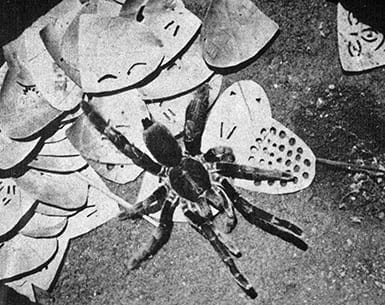
Kaka spider divination, Cameroon (1964). Photo by Paul Gebauer
My last example is the pangolin, another rather rare animal whose observed behavior seems ready for symbolic interpretation. Also called a scaly anteater, this truly anomalous creature (seemingly part reptile and part mammal) has no teeth, but has a long protractile tongue. The solitary, nocturnal pangolin quietly moves through the undergrowth hunting for insects. Although possessing poor eyesight, it has acute senses of hearing, smell, and taste—a reminder that divination is multisensory. Since hearing is greater than sight for the pangolin, it reminds us that, universally, there are many blind “seers” or diviners, but few, if any, deaf diviners.
When threatened, the pangolin rolls up into a ball, presenting only its large, hard scales to its enemies. This feature has been adapted by Luba diviners, who wear beaded hats with pangolin patterns to protect their heads. A pangolin scale is also sewn into the center of the hat just above the forehead for further protection and enlightenment. In some other Central African divination systems, marked pangolin scales are cast and read by diviners.
With such an array of divination systems, clearly one should be very cautious of any generalizations. Years ago, Benneta Jules-Rosette17 discussed the similarities between anthropology and divination; both pursuits attempt to sort out foreign cultures, to determine meaningful utterances from background noise, and to translate from one system to another. Fully appreciative of such dangers, I will still suggest a way to understand this widespread use of normally silent creatures.
Throughout Africa, the talkative, verbose individual is considered neither wise nor knowledgeable. It is the reticent person who is the sage. Because good speech, wise words, and deliberate communication are so highly valued, the one who seldom speaks is the one to whom we should listen.
Twins serve as a model because of their special rapport, their extraordinary ability to communicate, often without words. Thus, diviners seek in their relations with other beings (and with clients) that “perfect knowledge of each other” which transcends usual human communication. Also demonstrating the value of nonverbal interaction, “silent” animals are used in these critical cross-world communications because their normal silence serves as a reminder of the wisdom of the quiet elder, the person of few but important words.
Let me end with a story that illustrates the wisdom of silence and serves as a cautionary tale to any speaker. The story “The Talking Skull Refuses to Talk” is widespread in Africa and is the most widely recorded tale among African Americans:
A hunter found a human skull in the forest and asked, “What brought you here?” The skull answered, “Talking brought me here.” The hunter ran and told the king that he had found a skull that talked. The king did not believe him and sent a guard to see if his story was true, with orders to kill him if it was not. All day long the hunter begged the skull to speak, but it remained silent and the hunter was killed. When the guard had left, the skull asked, “What brought you here?” The hunter’s head replied, “Talking brought me here.”18
The lesson so emphatically learned is to choose your words—and time of speech—wisely. Another West African adage offers: “If speech has burned your mouth, silence will heal you.” Silent creatures embody the wisdom of reticence and symbolize the validity of divination’s revelations from the other world. Just as the measured, deliberate speech of the elders should be carefully attended, so, too, should the “words” carried by “silent” creatures.
Notes:
- From African Divination Systems: Ways of Knowing, ed. Philip M. Peek (Indiana University Press, 1991), 2.
- Ellen Suthers, “Perception, Knowledge, and Divination in Djimini Society, Ivory Coast” (PhD diss., University of Virginia, 1987), 11–12, 16.
- See my introduction to Twins in African and Diaspora Cultures: Double Trouble, Twice Blessed, ed. Philip M. Peek (Indiana University Press, 2011).
- René Devisch, “The Slit Drum and Body Imagery in Mediumistic Divination among the Yaka,” in Insight and Artistry in African Divination: A Cross-Cultural Study, ed. John Pemberton III (Smithsonian Institution Press, 2000), 116–133.
- Rudolph Blier, “Diviners as Alienists and Annunciators among the Batammaliba of Togo,” in African Divination Systems, ed. Peek, 73–90.
- Mary Nooter Roberts, “Proofs and Promises: Setting Meaning before the Eyes,” in Insight and Artistry in African Divination, ed. Pemberton, 63–82.
- Suthers, “Perception, Knowledge, and Divination,” 11ff.
- Piet Meyer, “Divination Among the Lobi of Burkina Faso,” in African Divination Systems, ed. Peek, 91–100.
- Blier, 85.
- Dominique Zahan, The Religion, Spirituality, and Thought of Traditional Africa, trans. Kate Ezra Martin and Lawrence M. Martin (University of Chicago Press, 1979), 113.
- T. O. Beidelman, “Ambiguous Animals: Two Theriomorphic Metaphors in Kaguru Folklore,” Africa 45, no. 2 (April 1975): 191.
- I cannot resist noting that the use of silent creatures is not exclusively an African divination phenomenon. Many Europeans still recall the extraordinary success of Paul the Octopus who predicted, from the confines of a German aquarium, winners of the European Cup in soccer.
- Allen F. Roberts and Carol A. Thompson, Animals in African Art: From the Familiar to the Marvelous (Museum for African Art, 1995), 66.
- Lorenz Homberger, “Where the Mouse Is Omniscient: The Mouse Oracle among the Guro,” in Insight and Artistry in African Divination, ed. Pemberton, 157–167.
- Doran Ross, “The Verbal Art of Akan Linguist Staffs,” African Arts 16, no. 1 (November 1982): 56.
- See Walter E. A. van Beek, “Crab Divination among the Kansiki/High of North Cameroon and Northeastern Nigeria,” in Reviewing Reality: Dynamics of African Divination, ed. Walter E. A. van Beek and Philip M. Peek (LIT Verlag, 2013), 185–210.
- Benetta Jules-Rosetta, “The Veil of Objectivity: Prophecy, Divination, and Social Inquiry,” American Anthropologist 80, no. 3 (1975): 549–570.
- William Bascom, “African Folktales in America: I. The Talking Skull Refuses to Talk,” Research in African Literatures 8, no. 2 (1977): 266–291.
- Senufo Sandogo diviner, Côte d’Ivoire (2001).
Philip M. Peek is Professor Emeritus of Anthropology, Drew University. He has published extensively on African visual and verbal arts and divination systems and currently is researching the lower Niger Bronzes of southern Nigeria. This essay is a modified version of a talk presented at the Peabody Museum of Archaeology and Ethnology at Harvard University on October 25, 2012.
Please follow our Commentary Guidelines when engaging in discussion on this site.

